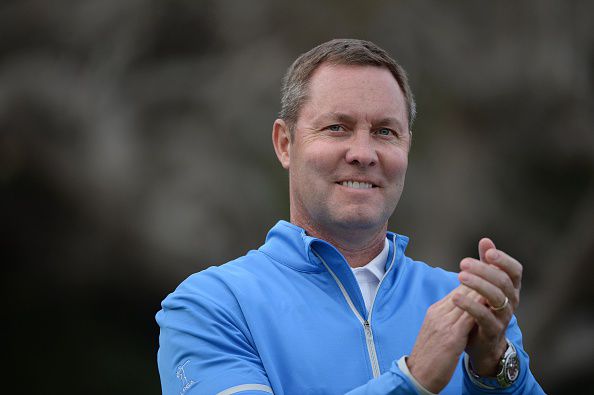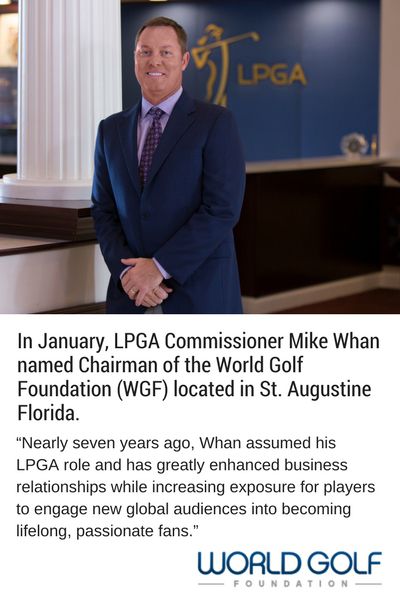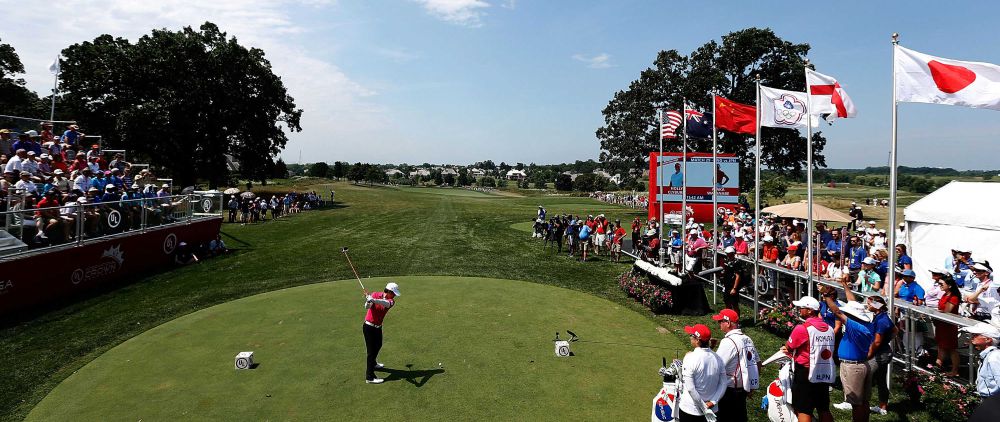LPGA Commissioner Mike Whan, the eighth Commissioner of the LPGA, has been honored twice in 2017, and the year isn’t even half over! Many Commissioners have had an important role in expanding the LPGA Tour. And Mike Whan will rate among the best.

I have interviewed the Commissioner many times beginning in January 2010 when he was hired to reverse the downward spiral of the LPGA. Two years ago in 2015, we spoke at length in an interview at his office in Daytona Beach, Florida. (See My Conversation with LPGA Commissioner Mike Whan.) Most recently, on May 2, 2017, I had the opportunity to interview the Commissioner again.
He describes his leadership style as “Listen, Learn, Lead.” And we have talked at length about his marketing principles and strategic thinking. In fact and with full disclosure, I belong to the “Mike Whan Fan Club.”
One of the keys to his success in my view is that the Commissioner truly loves the game of golf. During our recent conversation, he spoke nostalgically about his teenage years as a caddy and playing golf with his father. He didn’t talk about how well he golfed but about the unique personal time that he and his father shared on the golf course. In fact, based on all of my conversations with the Commissioner over the years, I am convinced that he believes that no other sport – except golf – provides a comparable opportunity for sharing personal experiences and developing meaningful relationships. That conviction is a key to his success as Commissioner.
Ironically, most of his time now is devoted to delivering and selling women’s golf via the impersonal venue of television. However, he still works hard at maintaining personal relationships with his staff, players on the LPGA Tour, Symetra Tour, tournament sponsors, key members of other golf associations and even golf writers like me. His two honors mentioned at the beginning of this interview and detailed below, are a testimony to the breadth of his relationships and respect within the industry.
The Commissioner also has a strong marketing background. His first job out of college was at Procter & Gamble marketing toothpaste. With his sports background, he moved on to a new role with Wilson Sporting Goods and then a marketing position at TaylorMade golf. And immediately before joining the LPGA, he was the CEO of Mission-Itech Hockey.
Marketing requires knowing what will attract customers – whether it’s marketing “tradition” like a Rolex Watch or “excitement” like a 40-foot putt to win a championship on the last hole of a sudden-death playoff. Commissioner Whan, in my opinion, has that marketing gene. He knows what will excite current golf fans and what might attract new ones and his mission is to deliver that magic connection.
Another quality of the Commissioner that impresses me is his strategic thinking. Without a strategy and related goals, marketing dollars and efforts are often wasted and useless. The Commissioner is guided by one important and consistent strategic principle which is: “Golf is a tough one to market if people can’t see it.” Mike’s concern is valid: How will a person know they like golf if they can’t see it played? It’s a basic marketing challenge. That is why TV viewership of LPGA events crops up frequently in our discussions.

The Commissioner and I spent about 90 minutes on the telephone on May 2nd discussing my list of 18 questions. My practice is to tape our conversations, then transcribe the tapes and then edit the conversation to capture the essence of what readers will want to know about the Commissioner and where women’s golf is heading under his leadership.
But as I reviewed the tapes of our recent interview, I was overwhelmed. There was so much to write about and so many of his comments that I just wanted to put in quotes. In fact, the working title for this article was “The Quotable Commissioner.”
But, I decided to write our interview as a typical Q&A conversation. I used the exact words of the Commissioner where possible. But where I could not, my paraphrasing in both words and tone is very representative of our actual conversation.
During our conversation, the Commissioner described himself several times as having an “ADHD” personality – an attention-deficit personality. He likes big-picture thinking and can’t stay in the “weeds” for very long without getting restless. Consistent with his personality, he reports that he came on the job as Commissioner in 2010 with just a three-page plan of how to fix the LPGA’s complex problems.
The Commissioner’s impatience with details and his preference for thinking in broad strokes is also his strength. He is comfortable taking risks. So that’s where I decided to begin our interview.
RISKS AND REWARDS
Q. In the announcement about your recognition as Sports Executive of the Year, the article called attention to your “bold risk taking” so I am going to begin there. What do you think was the first bold risk you took as Commissioner?
 A. As my mind races back, I think my first risk came early in my role as Commissioner. In 2011, I introduced a tournament without a purse – no prize money. It was the RR Donnelley Founders Cup.
A. As my mind races back, I think my first risk came early in my role as Commissioner. In 2011, I introduced a tournament without a purse – no prize money. It was the RR Donnelley Founders Cup.
Note from Nancy: The “Founders” are the 13 women that established the LPGA in 1950. Read more and see the photos at lpga.com/news/founders-and-pioneers.
We offered a “mock” purse – not real money at all – although players did move on the official money list. I was ridiculed in the press about it. And I was worried that other sponsors would say that they didn’t have to put up prize money either. I had a lot of sleepless nights. But, strategically, the Founders Cup was a way I thought that I could create interest in a Tour that wasn’t drawing much interest. It was a “bold” move.
As a risk, I felt like I was jumping off a cliff holding hands with a couple of people and everyone on top of the cliff was watching us and saying, “Good Luck.” But that tournament today – now the Founders Cup – has probably had a bigger influence and impact on girl’s golf than anything we have done. In that first year, we honored our LPGA Founders along with a few others pioneers. These were great women golfers who picked up the baton and handed it to someone younger or faster.
Another risk I remember was announcing a fifth “Major” for 2013 – the Evian Championship played in France at the Evian Resort Golf Club. This tournament was founded by the Ladies European Tour (the LET) in 1994 as the Evian Masters. In 2000, we added the Evian Masters to our LPGA schedule as a regular tournament – not a Major.
Note from Nancy: A “Major” tournament usually draws a stronger field with more prize money and more points for the Rolex Rankings and other point-driven awards.
In the way of background, before I became Commissioner, I viewed myself as a traditional guy and liked to keep traditions. Four “Majors” on the LPGA calendar was a tradition I inherited. After my second year as Commissioner, I realized that I had to give our players bigger stages and bigger moments.
We needed to make our bigger events bigger to give them long-term stability for future golfers. I want our nine, ten and eleven-year-old girls to see those moments. When they are putting, I want them to say: “This one is for jumping into Poppie’s Pond” or “This one is for winning the U.S. Women’s Open.” My marketing background taught me the importance of creating experiences that were unique. So we had a skydiver at the Evian Championship jumping out of the plane and wrapping the player in her country’s flag. Now those moments are part of the LPGA’s “lore” – our history.
Q. There’s one risk that we haven’t talked about so far – the “global” LPGA. It came early in your role as Commissioner and was challenged by many within the industry.
A. Yes, probably the risk that received the most attention was when I transitioned the LPGA Tour into a global tour. But ten years ago no one could see it. That certainly was a risk! Now 170 countries in five continents are watching women’s golf. Being a global tour is probably our greatest competitive advantage as a sport.

Q. The global mission is holding up but as purses get bigger, do you have to worry about players not committing to as many events because they have earned enough in prize money?
A. If you want fans and sponsors and TV partners all over the world, we are going to take our tour on the road because that’s the only way they will want the tour to follow us on their local media when we are not their country. This goes back to what I said before that the game of golf is a tough one to market if people can’t see it. We are fully committed to being a global tour. But we are also still committed to having North America as our home. We play 65% of our time in North America.
Q. Would you ever put in a quota that a LPGA Tour player must play in a fixed number of events?
A. No. I feel like what I need to do is deliver the best opportunity I can for women golfers. I am committed to a global tour, and that means that our players must travel.
But because of the travel demands, I am committed to some type of “off season” that allows our players to rest and stay healthy. In the summer, some players take a break. After Thanksgiving, we break and don’t come back and start the season until the middle of January. In a perfect world, I might have more breaks.
I am very concerned about our players and their schedule. But, I deliver for the check-writer who sponsors our tournaments. Remember that when I worked at P&G and other companies, I was the “check-writer.” I know what the demands are. I have to have enough tournaments for the check-writers and enough breaks for the players to stay healthy and fresh for tournaments. Prize money goes up when there is a better field.
Q. We have talked a lot about risks, and you have taken. Are there some lessons you’ve learned along the way?
A. The first lesson is that there are always naysayers. For example, adding the Evian Championship in France as a fifth major raised questions about whether the LPGA was upsetting “history” and that playing five majors in a year would make historical comparisons difficult. The reality is that throughout history, women’s golf has had a number of different majors in a year (2,3,4 and 5), so it became less of an issue.
Q. How do you handle the opposition to change?
A. Everyone says they want change… until you change it. But sports that are willing to change are the sports that will stay with us. However, I don’t always believe that change is the right strategy.
Q. Let’s follow up on that answer: What change or risk did you reject?
 A. One that comes to mind is about the Solheim Cup, which is coming up soon in Iowa in August. As you know the Solheim Cup is between Team USA and Team Europe. But with all the international expansion in golf and my global strategy, there was some pressure to include Asia as another region in the Solheim Cup. But, I remember being at my first Solheim Cup, with the excitement and emotion, and saying to myself: “I hope I never mess with this.” And I didn’t!
A. One that comes to mind is about the Solheim Cup, which is coming up soon in Iowa in August. As you know the Solheim Cup is between Team USA and Team Europe. But with all the international expansion in golf and my global strategy, there was some pressure to include Asia as another region in the Solheim Cup. But, I remember being at my first Solheim Cup, with the excitement and emotion, and saying to myself: “I hope I never mess with this.” And I didn’t!
But I recognized that there are fine players in Asia, Australia, and South America who are not eligible for the Solheim Cup. So we started talking about a new international tournament. But a US team against the rest of the world didn’t make sense. How would you dress for “Rest of the World?” In addition, some countries, for political reasons, don’t want to play with other countries in the “rest of the world.” They didn’t want to have members of their own team that they really wanted to beat.
And that’s what led us to create the International Crown tournament held in alternate years of the Solheim Cup.
We decided to make everything different about the UL International Crown. We wanted to create something that golf hasn’t seen before. I guess that confirms that I am a “risk-taker!” I expected the UL International Crown to be negatively critiqued in the first year because it doesn’t compare to anything.
See background on the LPGA UL International Crown.
But now I am really proud of it. The 2018 UL International Crown event will be the third tournament and will be held at the Jack Nicklaus Golf Club in Incheon, South Korea. I really believe that the Solheim Cup and the UL International Crown will become the “Showcases” of women’s golf and women’s sports worldwide.

Q. You are comfortable with the risks you take to benefit the Tour. But what about the LPGA players? How do they react to your risk-taking?
A. Players take risks also. When you spend time with the players like I do, it’s amazing to watch a 25-year-old rework her swing to get seven-to-ten yards longer off the tee. I say to myself: “Why change anything? You are doing so well.” And their answer is that they can get better. The LPGA Tour players don’t want to just make cuts. They want to raise trophies. So the players are taking major risks also.
And players take those risks in front of everyone and let every TV commentator critique a new putting stroke or wedge shot and hear comments like, “I remember when they could hit those shots.” My athletes understand this risk taking.
I remind them and ask them to understand that the organization itself has to take some risks also. I don’t want to be the same LPGA in 2025 that we were in 2015. No company got to be 100% bigger by concentrating on 3% growth. If you want to really be bigger, you have to take big swings.
SUPPORTING THE ‘CHECK-WRITERS’
Q. The LPGA took a risk with a “match play” event on the schedule this year, the Lorena Ochoa Match Play tournament in early May in Mexico City. How do you evaluate that risk?
 A. Tournaments go through good times and bad times. The risk was not in having a “match play” event. There were other factors. After Lorena had retired from the Tour to move back to Mexico, marry and raise a family, she hosted a successful tournament in Mexico for several seasons on the LPGA Schedule. That wasn’t a big risk because we had the sponsors that paid for the production costs that allowed us to televise the tournament.
A. Tournaments go through good times and bad times. The risk was not in having a “match play” event. There were other factors. After Lorena had retired from the Tour to move back to Mexico, marry and raise a family, she hosted a successful tournament in Mexico for several seasons on the LPGA Schedule. That wasn’t a big risk because we had the sponsors that paid for the production costs that allowed us to televise the tournament.
But the recession – remember we are operating on a global stage — caused pain for many of our sponsors who write the checks that pay for the TV production costs. And there just were not enough check-writers for the Lorena Ochoa tournament to be televised. Not everyone realizes that it costs about $1 million dollars in production costs to televise a tournament—that’s laying 6000 yards of TV cable on a course plus all the other extras.
When a sponsor says they can’t get there – come up with that money, I have a choice of saying “Good Bye” or trying to make it work. But saying goodbye is not what a sports partnership is all about. So this season we had the tournament, but we made it a local Mexico City event and did our best on our LPGA website and social media for our fans to follow it.
But golf is a tough sport to market to fans if they can’t see it being played. I realize that.
Q. But what do you do when other sponsors for one reason or another can’t come up with the funding.
A. The question I ask is “Where are we when someone is facing bad times?” It’s not like a standard CEO who can say “Sorry the price is “X” and if you can’t afford it, you are out.” That’s what happened a decade ago, and that’s why the LPGA was looking for a new Commissioner.
I have a different view. It helps that earlier in my career and operating a corporation; I was the “check-writer.” I know what that role involves. But, when someone thinks about what kind of partner the LPGA is, I want them to think about the time they needed us and we were there.
I could list ten tournaments that at some point couldn’t come up with the funding to sponsor a tournament. We didn’t say “Good Bye,” and nine of those ten are back with us. The PGA Tour has been great at bridging the gap when between major check writers when some just step away from sponsorship. There’s a risk that will happen. The LPGA has to do a better job at bridging the gap between check writers. We need to get our LPGA Board and my team to learn how to be a better “partner.”
Q. I want to go back to the Lorena Ochoa tournament. The way the match-play matches were organized was clever – four different fields and then there was an exhibition match the final day among Juli Inkster, Annika Sorenstam, Sei Re Pak and Lorena Ochoa. Many golf writers, as well as fans on social media, commented that there must have been a way to have it taped or streamed.
A. Here are the basics which not everyone is probably aware of. In order to stream a tournament so that fans can watch it on their mobile devices – that’s the “distribution” part – it first has to be “produced.” The cost of producing the event is the cost of 6 miles of cable, 45 people, a production truck – that’s for starters. It costs about one million dollars to “produce” a tournament. We can’t cover a TV golf tournament with a walking camera man. It’s the cost of producing the event that is the first hurdle.
GOLF FASHION
Q. I’m going to come back to streaming and new technology in another context, but in the meantime, let’s make an 180-degree turn. Let’s talk about the dress code on the LPGA Tour. My latest article on womensgolf.com featured a photo of Michelle Wie in the newest Nike fashions with the shortest skort I have seen on Tour.

Here’s the current LPGA dress code from the LPGA website:
“We allow sleeveless and collarless shirts to be worn during play. There is no specific length requirement on shorts or skirts. Denim, cut-offs, workout clothes are not allowed.
I don’t think many golf facilities – at least in the U.S. – would allow women to wear skorts, shorts or skirts as short as those worn by Michelle. But, my question is a simple one: “Do you ever review the LPGA dress code?”
A. We rethink it every year. But when I spoke with a LPGA Founder who commented on the new styles and compared it to what she used to wear in 1960, I asked her what she wore when she went shopping. She said, “The same thing I wore on the course.” So I reminded her that it’s the same situation today. The 20-year-olds on our tour wear the same thing on the golf course that they wear to the mall or movies. But, I hear what you are saying. We do have to have some guidelines.
INNOVATION WITH TOPGOLF
Q. Let’s move on to something very new: Topgolf. For readers not familiar with Topgolf, I am just going to describe it as an indoor stadium-type driving range that has more in common with the experience of a bowling alley than a golf course. There are currently about twenty Topgolf facilities in the U.S. Do you think Topgolf is a risk to traditional golf? Will it keep golfers off our traditional courses?
A. “I am over the moon with Topgolf.” We have hosted girls’ golf clinics at Top Golf and Pro-Am events at Topgolf. And this is news: We are talking with Topgolf now about a tournament idea where would have a combination of a Topgolf and a green-grass tournament.

I don’t consider it a risk at all to traditional golf. In fact, it’s just the opposite. Here’s how I explain it: I haven’t played football in more than 30 years, but I did play it and respect how hard it is. I have an appreciation for it. That makes me more than a “regular” golf fan.
Going back to Topgolf. I think that when you hit a 5-iron on a golf course, you will have more appreciation when you watch a pro hit a 5-iron. I’m not sure of the statistics, but I think 40-50 percent of people walking out of a Topgolf venue have never been on a golf course in their life. We are introducing the game to 8 million people a year who otherwise wouldn’t know the game. Do I think they are likely to be part of our TV audience? Yes, highly likely!
We need to be embracing Topgolf with arms wide open. For example The night before a Pro-Am, we have our LPGA players meet the golfers they will be playing with in the Pro-Am. We invite our guest/amateurs to a stall where the LPGA professional will be. They can meet and have fun. It’s much better than being in Room 3B of a hotel for a pre-pro-am event.
Note from Nancy: For more information about Topgolf visit Topgolf.com.
Q. I would like to be a better golfer myself. Whatever happened to those “lessons” that used to come up during televised tournaments? Only a few commentators – Judy Rankin is a perfect example – really offer any golf tips that women golfers can relate to?
A. We had more of those back in 2011 and 2012. They had different names. We called some “Teachable Moments Brought to You By…” And we had one: “Caddy Knows Best.” Those lessons needed sponsorship by the way. But now with eight annual reviews with the Golf Channel about our TV fan base, we are learning more about what viewers want. And according to the Golf Channel, what viewers want most is to see: “Balls in the air” – that’s their phrase. They lose folks along the way when the cameras break away from the tournament. That’s why we do less of those lessons now. Personally, I liked those short interviews with the players, but those are gone also.
Q. What about girls golf? The numbers in the U.S. are holding steady and really looking good. What’s driving that growth?
A. There used to be a lot of organizations pulling on a rope and building girl’s golf. They were pulling in the same direction, but never on the same rope. For example, ten years ago there was LPGA/USGA Girls Golf, The First Tee and the PGA of America introduced a new youth golf “league” program. We realized that we needed facilities for our LPGA Girls Golf programs and The First Tee needed girls. We just didn’t know each other ten years ago and didn’t spend time together. But that has changed. Now, 60% of our Girls Golf growth is coming from our partnership with The First Tee. And three times a year, I am on a Board call that talks about Girls Golf. It’s really a different world.
CHANGES TO THE RULES OF GOLF

Q. What about the recent ruling on Lexi Thompson? Has there been some additional thinking about the viewer call-ins?
A. Regarding Lexi, that was a painful circumstance and one that is hard to swallow for any fan, including the Commissioner. Sometimes the rules of golf can be hard to understand and support, but I certainly don’t have the right to overturn rulings that are 100% based on the Rules of the Game.
That said, I have been both encouraged and supportive of the USGA and the R&A‘s efforts to streamline the rules and listen to the feedback, driven by competitive experiences from the different Tours. Three weeks after the ANA Inspiration, a couple of rules that were slated to go into effect in 2019, were implemented in April of 2017. These changes were not directly related to, or in response to the situation at ANA, but both rules will be more suited for today’s TV-driven tour golf.
Separately, as it relates to viewer input/call-ins, the USGA and R&A have organized a “working group” from the world’s leading tour officials, to assess changes as it relates to outside input/suggestions and the closing of each day’s round. I’m not sure where this group will net-out, but I’m encouraged by both the responsiveness and inclusion of the world tours in this important effort.
Q. As usual, here’s the same final question I have asked in each of our previous conversations: What keeps you up at night? Or, if you had a magic wand that would grant you any wish for the LPGA, what would you ask for?
A. That’s easy. It’s a U.S. Network deal in addition to the Golf Channel where we have more LPGA Tour televised. We have proven to ourselves and the Golf Channel that we draw viewers. But we still don’t get much of a chance to show our Tour to as many people as the PGA Tour. We have seven tournaments network televised this season, but we need to take it to 14. We have to figure out how to do that.
Q. Mike, you answered the same question the same way last time we talked. That’s a concern. You quoted one of your dad’s favorite sayings to me: “It’s okay to have the same problems, but not the same problems each year.”
A. Yes, my father would be making fun of me with that answer.
Is it possible that I am asking the wrong question? Let me ask a different one: If the recent research I have been reading suggests that young women and men don’t want to sit in front of a TV for four hours watching “balls in the air” perhaps I should be asking what you are doing about reformatting televised golf tournaments? Maybe viewers don’t need to watch balls in the air. Maybe they only need a good commentator on each green and then with some of the new technology, perhaps the events could be streamed. Maybe your idea about Topgolf and a green-grass tournament is a good solution. I’ll make exceptions of course for the Majors and the Opens. But, I’m on your dad’s side right now.
Q: Here’s the final 40-foot putt question for the win: When you look back five years from now, what will you be most proud of?
A. I want to leave the game of golf better than the way we found it. If women who played the game in 1950, look back to the game today, I hope they see real progress. And we need to get golfers at age 12 to play golf now for them to play golf as millennials. Women’s golf is going to look different in the future.
Nancy – Mike, I couldn’t agree with you more! And yes, I’m one of those golfers who began playing decades ago, and I see real progress. Much of it is due to your leadership. So on behalf of all the millions of women in the world playing and enjoying golf, here’s a big “Thank You” from all of us.
All photos in this article are supplied and used with the express permission of the LPGA and may not be reproduced or redistributed.







